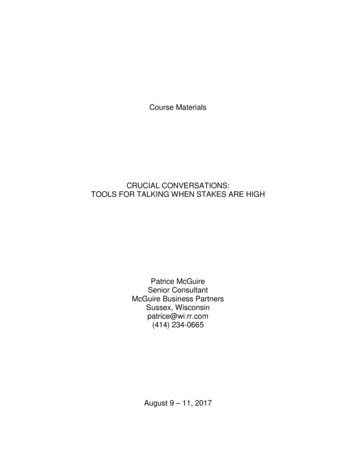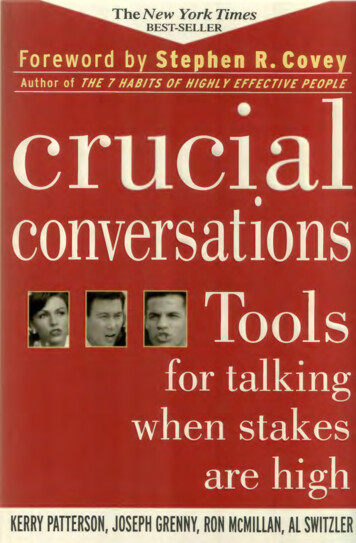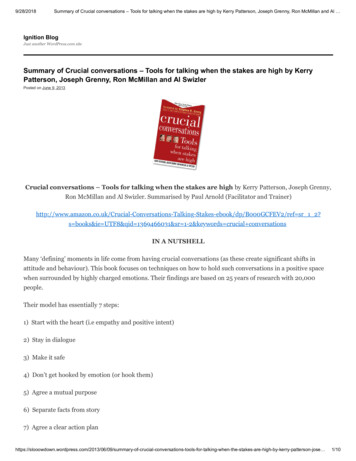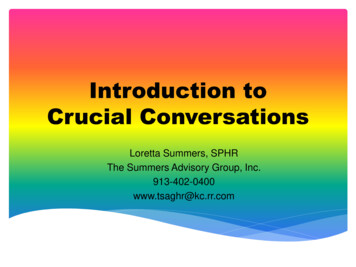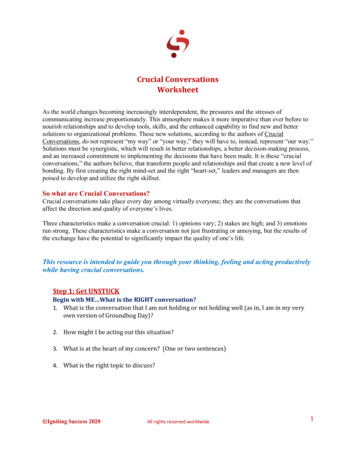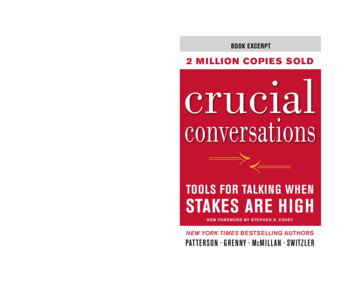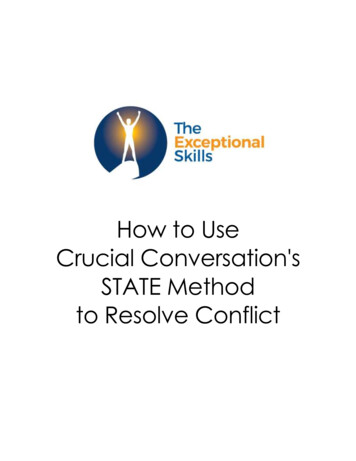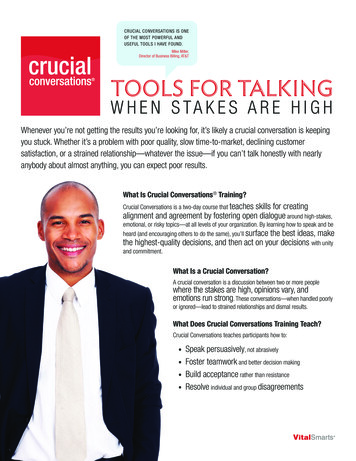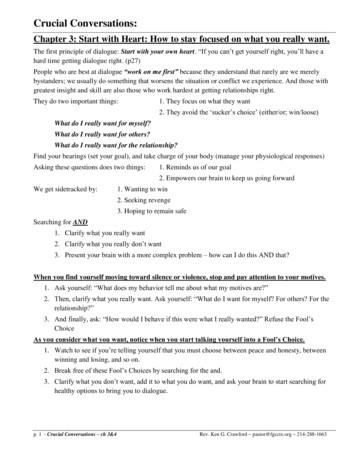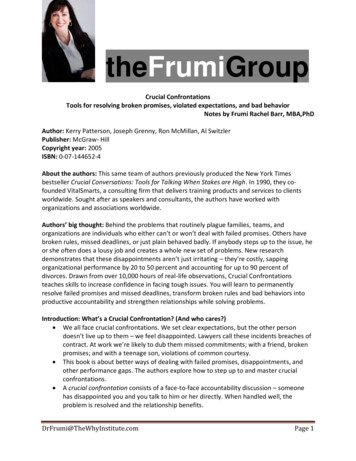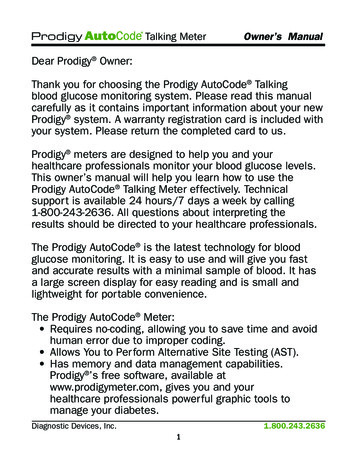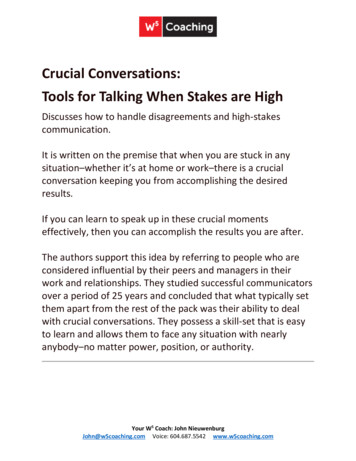
Transcription
Crucial Conversations:Tools for Talking When Stakes are HighDiscusses how to handle disagreements and high-stakescommunication.It is written on the premise that when you are stuck in anysituation–whether it’s at home or work–there is a crucialconversation keeping you from accomplishing the desiredresults.If you can learn to speak up in these crucial momentseffectively, then you can accomplish the results you are after.The authors support this idea by referring to people who areconsidered influential by their peers and managers in theirwork and relationships. They studied successful communicatorsover a period of 25 years and concluded that what typically setthem apart from the rest of the pack was their ability to dealwith crucial conversations. They possess a skill-set that is easyto learn and allows them to face any situation with nearlyanybody–no matter power, position, or authority.Your W5 Coach: John NieuwenburgJohn@w5coaching.com Voice: 604.687.5542 www.w5coaching.com
Chapter SummariesChapter 1: What’s a Crucial Conversation? And Who Cares? A crucial conversation is adiscussion between two or more people where stakes are high, opinions vary, and emotionsrun strong. When we face crucial conversations, we can do one of three things: We can avoidthem, we can face them and handle them poorly, or we can face them and handle them well.Ironically, the more crucial the conversation, the less likely we are to handle it well. We oftenhold things inside by going silent until we can take it no longer—and then we drop a bomb. Inshort, we move between silence and violence—we either don’t handle the conversation, ordon’t handle it well. We may not become physically violent, but we do attack others’ ideas andfeelings. When we fail a crucial conversation, every aspect of our lives can be affected—fromour careers, to our communities, to our relationships, to our personal health.Chapter 2: Mastering Crucial Conversations: The Power of Dialogue: Dialogue is the free flowof meaning between two or more people. At the center of dialogue lies a Pool of SharedMeaning. It contains the ideas, theories, feelings, thoughts, and opinions that are openlyshared. The more information we have in the pool, the better prepared we are to makedecisions and get results. Anything less than total candor shrinks the shared pool, sapsmotivation, and dumbs down decisions. Taking time to fill the pool leads to faster and moreeffective results than the game-playing that inevitably follows silence and violence strategies.Dialogue takes time. The alternative takes longer.Chapter 3: Start with Heart: How to Stay Focused on What You Really WantIn order to breakaway from silence and violence, we have to change our behavior. This calls first for a change inheart. Our first change in heart comes from realizing that as much fun as it would be to fix otherpeople, we need to work on ourselves first. We need to examine our personal role in anyproblem we encounter. Our next change in heart comes with a change in motive. As we findourselves forgetting our original goal of candidly and honestly adding meaning to the pool andinstead striving to look good, win, or achieve some other unhealthy objective, we need to askourselves, “What do I really want?” Also, while it’s true that sometimes we are caught in agenuine dilemma with only two bad options, most of the time we do have healthy alternatives.When it comes to crucial conversations, “and” thinking makes a great deal of sense. Replacing“either/or” thinking with “and” thinking provides a way to reduce the ill effects of adrenaline.By asking ourselves the “and” question, we force our brains to move to higher-level, morecomplex thinking.Your W5 Coach: John NieuwenburgJohn@w5coaching.com Voice: 604.687.5542 www.w5coaching.com
Chapter 4: Learn to Look: How to Notice When Safety Is at Risk When a conversation turnscrucial, we either miss or misinterpret the early warning signs. The sooner we notice we’re notin dialogue, the quicker we can get back to dialogue, and the lower the cost. As you pull out ofthe content of a conversation and learn to look for the conditions of dialogue, pay attention toearly warning signs. Learn to look for when a conversation becomes crucial, for signs of silenceand violence, and for your own style under stress. A large part of this is watching your actionsand emotions, as well as the actions and emotions of the other person. Paying attention toboth the content of the discussion and how people are acting and feeling is no easy task. Butit’s an essential part of dialogue.Chapter 5: Make It Safe: How to Make It Safe to Talk about Almost Anything When things gowrong in crucial conversations, we assume the content of our message is the problem, so webegin to water it down or avoid it altogether. But, as long as your intent is pure and you learnhow to make it safe for others, you can talk to almost anyone about almost anything. The key isto make the other person feel safe. To do this, there are two things the person needs to know.First, they need to know that you care about their best interests and goals. This is called mutualpurpose. Second, they need to know that you care about them. This is called mutual respect.When people believe both of these things, they relax and can absorb what you’re saying; theyfeel safe. The instant they don’t believe them (and it can happen instantaneously – even withthose we have long and loving relationships with), safety breaks down and silence or violencefollows. To restore safety in the face of silence or violence, you must restore mutual purposeand respect.Chapter 6: Master My Stories: How to Stay in Dialogue When You’re Angry, Scared, orHurt When we become upset, our most common reaction is to defend ourselves and place theblame on someone else. As convenient as it is to blame others for pushing our buttons andcausing us to become upset, it’s not exactly true. The key to how we feel lies in the stories wetell. These stories consist of our guess as to why people do what they do. As we becomeemotional, our story seems to be “What is the worst and most hurtful way I can take this?” Thisnegative spin escalates our emotions and causes us to do the worst when it matters the most.To break away from your volatile emotions, you must rethink the conclusions you drew and thejudgments you made. That requires you to tell the rest of the story. New (more accurate andcomplete) stories create new feelings and support new and healthier actions. Better still, newstories often encourage you to return to dialogue.Your W5 Coach: John NieuwenburgJohn@w5coaching.com Voice: 604.687.5542 www.w5coaching.com
Chapter 7: STATE My Path: How to Speak Persuasively, Not Abrasively To speak your mindcompletely in a way that allows room for dialogue, you must express your views in ways thatmaintain safety, and you have to find a way to be both confident and humble. You have toknow how to speak without offending and how to be persuasive without being abrasive. Thefive skills contained in this chapter help us do just that – to confidently state our opinions andhumbly and sincerely invite others to do the same. The five skills that help us share our toughmessages can be easily remembered with the acronym STATE. It stands for: Share your factsTell your story Ask for others’ paths Talk tentatively Encourage testingChapter 8: Explore Others’ Paths: How to Listen When Others Blow Up or Clam Up As we seeothers moving to silence or violence–sharing mostly stories or very little at all–it helps us stay indialogue if we can encourage them to share their entire Path to Action, or the explanation ofhow emotions, thoughts, and experiences lead to our actions. We have to find a way to moveothers back to their facts. We typically join them at the end of their Path to Action. They showus their feelings and share their stories, but we may not know what they actually observed. Weknow what they think, but we don’t know what we or others may have done. When others goto silence or violence, actively explore their path. Exploring helps others move away from harshfeelings and knee-jerk reactions and toward the root causes of those feelings and reactions. Italso helps curb our own defensive response. Rather than ask, “What’s the worst and mostpersonal way I can take this?” (leading to defensiveness), we should ask, “Why would areasonable, rational, and decent person think or feel this way?” (leading to curiosity). It’s hardto feel defensive and curious at the same time. Finally, it takes us to the only place where thefeelings can be resolved: The source (the facts and story behind the emotions).Chapter 9: Move to Action: How to Turn Crucial Conversations into Action and Results Theultimate goal of dialogue is not just to create a healthy climate or even a clear understandingbetween parties. While both are helpful outcomes, both fall short of the real purpose: To getunstuck by taking the appropriate action. If you don’t take action, all the healthy talk in theworld is for nothing and will eventually lead to disappointment and hard feelings. Always agreeon when and how follow-up will occur. It could be a simple e-mail confirming action by a certaindate. It could be a full report in a team meeting. It could be just one report upon completion, orit could be progress checks along the way. Regardless of the method or frequency, follow-up iscritical in creating action. There is no accountability if there is not an opportunity to account foraction. Document your work. Effective teams and healthy relationships are supported byYour W5 Coach: John NieuwenburgJohn@w5coaching.com Voice: 604.687.5542 www.w5coaching.com
records of the important decisions made after difficult dialogues, and the assignments agreedupon. Good teams revisit these documents to follow up on both the decisions and thecommitments. When someone fails to keep a commitment, candidly and directly discuss theissue with him or her. As you do so, everyone benefits in two ways. First, you increase themotivation and ability of the individual to do better. Second, you develop a culture of integrityin the team or relationship—letting everyone know that keeping commitments is an importantvalue.Chapter 10: Putting It All Together: Tools for Preparing and Learning: This chapter helps withthe daunting task of making dialogue tools and skills memorable and useable. If we first learn torecognize when safety is at risk and a conversation becomes crucial and that we need to takesteps to Make It Safe for everyone to contribute his or her meaning, we can begin to see whereto apply the skills we’ve learned. Using these tools and reminders will get us started inmastering the skills that help us improve our crucial conversations.Chapter 11: Yeah, But: Advice for Tough Cases Many people think the skills in this book don’tapply to the situations they care about most, but in truth, the dialogue skills discussed apply tojust about any problem you can imagine. However, since some situations are more difficultthan others, the authors chose seventeen tough cases and share solutions to each problem.Chapter 12: Change Your Life: How to Turn Ideas into Habits In this chapter, the authorsdiscuss several factors that affect the success of a crucial conversation as well as four principlesfor turning ideas into action. First, master the content. Learn to recognize what works and why,and how to break away from scripts, or pre-bundled phrases used in common conversations.Instead generate new scripts of your own. Second, master the skills. Understanding a conceptisn’t enough. While it’s helpful, even necessary to talk the talk, you also have to be able to walkthe talk. You have to be able to say the right words with the right tone and nonverbal actions.Third, enhance your motive. You must want to change. You have to move from a passive sensethat it would be a good idea to change, to an active desire to seek opportunities. Ability withoutmotive lies dormant and untapped. Fourth, watch for cues. To overcome surprise emotion, andscripts, you must recognize the call to action. This is usually people’s biggest obstacle to change.If a problem doesn’t cue your new skills, you’ll return to your old habits without even realizingyou missed a chance to try something new.Your W5 Coach: John NieuwenburgJohn@w5coaching.com Voice: 604.687.5542 www.w5coaching.com
Crucial Conversations: Tools for Talking When Stakes are High Discusses how to handle disagreements and high-stakes communication. It is written on the premise that when you are stuck in any situation–whether it’s at home or work–there is a crucial convers
